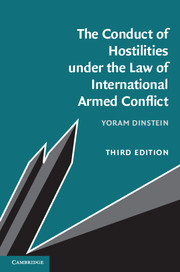Book contents
- Frontmatter
- Contents
- Introduction to the Third Edition
- Preface
- Table of cases
- Table of treaties
- List of abbreviations
- 1 The general framework
- 2 Lawful combatancy
- 3 Prohibited weapons
- 4 Lawful targets of attack
- 5 Protection from attack of civilians and civilian objects
- 6 Measures of special protection from attack
- 7 Protection of the environment
- 8 Specific methods of warfare
- 9 War crimes, orders, command responsibility and defences
- General conclusions
- Index of persons
- Index of subjects
2 - Lawful combatancy
Published online by Cambridge University Press: 05 April 2016
- Frontmatter
- Contents
- Introduction to the Third Edition
- Preface
- Table of cases
- Table of treaties
- List of abbreviations
- 1 The general framework
- 2 Lawful combatancy
- 3 Prohibited weapons
- 4 Lawful targets of attack
- 5 Protection from attack of civilians and civilian objects
- 6 Measures of special protection from attack
- 7 Protection of the environment
- 8 Specific methods of warfare
- 9 War crimes, orders, command responsibility and defences
- General conclusions
- Index of persons
- Index of subjects
Summary
Lawful and unlawful combatants
Combatants and civilians
112. The cardinal principle of distinction in LOIAC (supra 33–4) calls for a demographic bifurcation into two disparate categories of combatants and civilians. This bifurcation serves as a key to the normative architecture relating to the conduct of hostilities and susceptibility to attack. The goal is to ensure in every feasible manner that IACs are waged among combatants and that they will spare civilians.
113. Combatants are basically members of the armed forces of a Belligerent Party – whether these forces are regular or irregular, and irrespective of belonging to the standing army or to reservist units – including para-military militias incorporated de facto in the armed forces. The specific task assigned to an individual within the military apparatus is irrelevant. The main characteristic of members of the armed forces is that they are trained to engage in combat and fire weapons, even if in practice they serve in auxiliary or administrative position (ranging from legal advisers to drivers or cooks). Still, not all members of the armed forces are combatants. The exceptions are medical and religious personnel (see infra 135, 163).
114. The expression ‘members of the armed forces’ covers only those persons who are actually serving in the armed forces. Legal liability for conscription by itself does not turn a person into a combatant until he has been called up. Retirement from the armed forces moves a person back from the category of a combatant to that of a civilian.
115. The trouble is that, as a matter of increasing frequency in contemporary IACs, civilians, instead of keeping out of the circle of fire, take a direct part in the hostilities. When they do so, civilians are assimilated to combatants for such time as they engage in the hostilities (see infra 469 et seq.). Empirically, what counts therefore is not formal status alone (namely, membership in armed forces) but also conduct (namely, engagement in hostilities). Civilians directly participating in hostilities differ from combatants in that they are not entitled to act the way they do. But they do not differ from combatants in that they become lawful targets for attack.
- Type
- Chapter
- Information
- Publisher: Cambridge University PressPrint publication year: 2016



